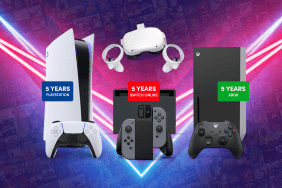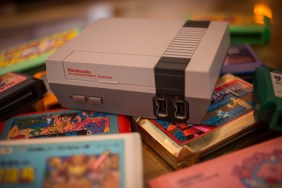In the mid-eighties, the Nintendo Entertainment System was released, reigniting America’s (and the rest of the world’s) love affair with video games. The console single-handedly created the video game market that we still see today, and set standards and trends for controller, games, and more.
In any successful growing market, competition breeds. And while Nintendo remained mostly unchallenged with the NES, their successor, the Super Nintendo would face off against an opponent in the first console war—a war that’s been fought console generation after console generation, and still wages on today with more savagely than ever.
Much of the time, the company in the best position to be the leader falters, leaving the underdog to rise to the challenge, gain new ground, and establish itself as a force. Let’s take a look at the console wars past, present, and future.
Super Nintendo versus SEGA Genesis
SEGA, a direct rival to Nintendo had released a system during the reign of the NES, but didn’t even manage to make a dent in Nintendo’s market share. Hoping to preempt Nintendo with a more powerful system, SEGA released the Genesis in 1989.
But SEGA had a tough road ahead. The name Nintendo and the Mario brand that was built along with it was stronger than ever. Fortunately, the two-year head start the Genesis had over the SNES meant that by the time the SNES released, the Genesis had amassed a larger library while being at a cheaper price point. And they now had a mascot of their own: Sonic the Hedgehog.
Despite Nintendo’s stronghold, SEGA’s marketing itself as the cooler console using slogans like “Genesis does what Nintendon’t” gave the Genesis the fuel it needed to eat away at Nintendo’s dominance. The end result left the two almost neck and neck sales-wise, with the SNES winning out by a total of roughly 49 million consoles sold to the Genesis’s 40 million.
Nintendo 64 versus SEGA Saturn versus PlayStation
Nintendo won, but SEGA gave them a run for their money. The two established giants would do battle yet again, but this time, a new contender had entered the console wars: Sony.
SEGA had long known it needed to do more to win against Nintendo, so they released the SEGA CD add-on. CD-ROMs were cheaper to manufacture, which allowed for lower prices on software. Not to be outdone, Nintendo paired with Sony to create a CD add-on for the SNES. Before it ever could hit the market, Nintendo backed out of the deal with Sony, instead going with Panasonic to produce an add-on that never saw the light of day. Sony was outraged, and instead took the technology to create and release a console of their own—the PlayStation—and it proved to be a thorn in Nintendo then and even today.
SEGA, having learned that a head start was important from their Genesis days, decided to have a surprise launch in the US, four months ahead of when it was originally planned to release. This turned out to be a big mistake, as less software was ready for the launch, and it allowed Sony to adjust their strategy—a strategy in which Sony priced the PlayStation $100 less than the Saturn.
The Saturn was notoriously difficult to develop for, which led to less third-party support, giving the edge to Sony and Nintendo. But it wasn’t all great for Nintendo, either. Nintendo opted to stick with a cartridge medium for software, raising the retail price of games significantly, making Sony the partner of choice for many third-party software publishers. Notable publishers making the switch include Squaresoft, makers of the Final Fantasy series.
Sony and the PlayStation went on to win this generation becoming the first console to sell over 100 million units. The Nintendo 64 was in a distance 2nd at roughly 33 million, and SEGA in dead last unable to break 10 million units sold.
PS2 versus Dreamcast versus GameCube versus Xbox
Sony, once the newcomer, now sat in the throne as king. But not only did Nintendo and SEGA want that crown, Microsoft had been eying it too.
SEGA struck again first with the Dreamcast, the first ever console to feature a built-in modem allowing users to play over the internet. The Dreamcast sold well, at first, that is until Sony released the PS2 with an ace up their sleeve: the PS2 doubled as a DVD player, and a very affordable one at that. Right at a time when DVD was beginning to replace VHS as the home video medium of choice, it made the PS2 a no brainer purchase for anyone looking to kill two birds with one stone. And having already been established with the PSOne, Sony had no trouble convincing consumers that the PlayStation 2 was the way to go.
Having released a year later, both the Nintendo GameCube and Microsoft Xbox never could catch up to Sony’s PS2 which eventually became the best-selling home console ever released with over 150 million consoles sold. The newcomer Xbox did a respectable 24 million units sold, with the GameCube right behind it at just under 22 million. The Dreamcast would become the demise of SEGA in the hardware business, selling only 10 million consoles. SEGA now publishes software on the consoles they once competed with. This was the one scenario where the dominant console manufacturer from the previous generation remained the champion. But the PS2 only made its rivals hungrier.

PS3 versus Xbox 360 versus Nintendo Wii
While Sony was still enjoying the longevity of the PS2, which still lives on even today, Microsoft was making their next move—a moved that proved time to work in the past: strike first. Microsoft released the Xbox 360 in 2005, giving them a year head start over Sony and Nintendo’s next consoles and a chance to build a library and a user base.
A year later, Nintendo released the grossly underpowered Wii against the HD-capable PS3 and 360. But it did have a secret weapon: motion control. That Wiimote and the Wii Sports pack in was enough to grab mainstream interest, sales, and success. Aside from some Nintendo first-party games, it left the hardcore gamer user base that once fueled Nintendo’s sales for the casual crowd. In a way, it paid off, because the Wii has went on to sell over 100 million consoles since its release. The underdog wins.
Sony on the other hand, coming off two incredibly successful console generations, tried to work their home video media magic twice by “future-proofing” the PS3 with a Blu-ray drive, driving up the price to a whopping $599—hundreds more than its competition. An arrogance accompanied this high price tag, suggesting that gamers would work more hours to own a PS3. At first, no one bought it, and all of these years later it’s only now begun to really pick up steam, closing in on the Xbox 360 thanks to strong sales in Europe and Japan.
After the initial rush of casual gamers flocking to the Wii ran thin, the Xbox 360 took over as the console to get in the US, and is close to surpassing the Wii in units sold in the US alone, but still has ways to go to catch up to the Wii’s 100 million consoles sold.
This generation’s war still wages on today, even with successors to the PS3 and 360 announced for release this holiday season, and Nintendo’s Wii U having already been on the market for over half a year now. It’s probably safe to say that the Nintendo Wii won this one, but at the sacrifice of loyal gamers who aren’t yet buying the struggling Wii U. The PS3 and 360 keep selling, but it’s only a matter of time before the PS4 and Xbox One release and gamers move on to greener pastures.

PS4 versus Xbox One versus Wii U
At the moment, Sony is enjoying early success with its marketing, support, and policies on the PS4, and Microsoft had to completely re-evaluate their strategy with the Xbox One due to overwhelmingly negative consumer feedback and outcry. The Wii U is struggling against the 360 and PS3 currently, failing to gain much of a head start over the upcoming PS4 and Xbox One. The casual gamers that gobbled up the Wii moved on to iPads and smartphones for their gaming fix, leaving Nintendo with another gimmicky controller, but without the software to give it reason to exist.
But as we’ve seen with previous console generations, anything can happen, and the underdog almost always wins.








